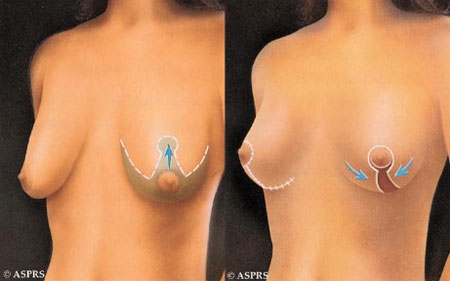Mastopexy (Lift)
Am I A Candidate?
Gravity, age, pregnancy and breast feeding, and a decrease in skin elasticity can change the shape and firmness of your breasts. As a result, your breasts may become pendulous and droopy, and the nipples may point downward and be located below the breast crease. A breast lift can improve the shape and contour of the breast in these instances. Although the procedure can be performed at any age, breast development must be completed. Pregnancy and breast feeding can still alter the shape and volume of your breasts in the future. Larger and heavier breasts are also more prone to recurrence of ptosis or droopiness.
If a surgeon tells you he doesn’t do breast lifts because he can fix things with a ridiculously large implant, think again. If the surgeon tells you he doesn’t do breast lifts because they don’t last, think again. If he tells you he doesn’t do breast lifts because “scars make women cry,” seek another opinion. These are excuses used by people who are not actual plastic surgeons, people who were not trained to perform breast surgery, or people with poor results.
How Is Surgery Performed?

The specific technique depends on individual breast characteristics and personal preferences. In general, the incisions follow the natural contours of the breast and delineate the area of skin to be excised and the new location of the nipple and areola. The shaded area represents the area of skin to be removed, while the nipple and areola are moved upward. No breast tissue is removed unless a reduction is planned. There are essentially three incisions involved. The first one is located around the areola. The second incision line travels down to the breast fold while the third follows the natural breast crease itself, creating an anchor design. The size of the areola can also be reduced. The sensation and the ability to breast feed usually remain intact because the underlying attachments to the nipple are preserved.
What Are The Risks?
Although rare, some of the potential risks of a mastopexy or breast lift that will be discussed with you at your consultation include bleeding, infection, and asymmetry. Occasional minor adjustments are sometimes required at a later date. Loss of nipple sensation can also occur. Revisional surgery is also required in cases where the incisions have healed poorly. Instructions and advice will be given to you before and after surgery to minimize your risk of these potential complications.
What Can I Expect?
A mastopexy or breast lift is usually performed on an outpatient basis. You are encouraged to get out of bed, but straining, lifting, and heavy exercise are discouraged for about 6 weeks. You should also sleep on your back during this time period. A supportive bra is worn and underwire bras are avoided for up to a month. Occasionally, sensation around the nipple may be diminished, sometimes requiring months before sensation is back to normal. Several months may also pass before your breasts achieve a more natural appearance and shape, while the incision lines begin to lighten.
How Long Do The Results Last?
A breast lift can enhance the firmness of your breasts as it uplifts them. Although permanently visible, the incision lines will fade over time and are easily concealed by clothing including low-cut necklines. As long as your weight remains constant and you don’t become pregnant again, the results of your breast lift should remain stable. Gravity and the effects of aging, however, are always present and patients occasionally undergo another breast lift procedure many years later. A more youthful contour can be achieved with a breast lift, and it is sometimes performed in conjunction with an augmentation to restore lost volume. Whatever your goals and desires, the best strategy and approach will be discussed with you at your consultation that is individualized and tailored to you and your body.
